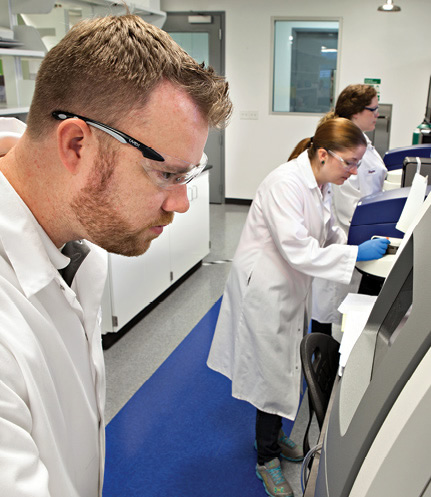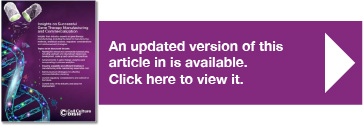
Overview of the Regulatory Path to Commercializing a Gene Therapy
After decades of research, gene therapies now comprise much of the R&D and manufacturing pipelines in the United States and around the world. Huge strides in biological understanding and the development of key enabling technologies are at long last delivering on the promises of precision and personalized medicines. While there is still much more to learn and develop, regulatory constructs keeping pace with the speed of innovation remains a sizeable challenge.
The guiding principle of successful regulation is to ensure patient safety. However, as novel therapeutics have emerged, meaningful challenges have manifested as regulators seek to define key attributes leading to efficacy and patient safety. Adding to the challenge is the accelerated speed in which many of these products are being brought to market as nearly all gene therapies under development have been assigned one of the FDA’s expedited approval designations.
Overview of FDA’s Expedited-Approval Designations
The FDA’s and U.S. Congress’ objective of speeding the path to market for therapeutics to address unmet medical needs started with the Accelerated Approval Program introduced by the FDA in 1992. Additional legislation including the FDA Modernization Act of 1997, the FDA Safety and Innovation Act of 2012 and the 21st Century Cures Act of 2016 provided further expedited approval pathways. Currently, there are five expedited approval designations:
Fast Track designation – This designation is for therapies that treat serious conditions where there is an unmet medical need and they receive the benefit of more frequent meetings and communication with the FDA, a rolling review of the Biologic License Application (BLA) or New Drug Application (NDA), and qualify for Accelerated Approval.
Breakthrough Therapy – This designation is assigned to drugs that treat a serious condition when preliminary clinical data show significantly improved outcomes compared to treatments currently on the market. Breakthrough therapies are eligible for: Fast Track designation benefits, and extensive FDA guidance early in the development process, as well as organizational commitment, including access to FDA senior managers.
Accelerated Approval – This can be given to drugs that meet a serious unmet medical need, and approval is based on a surrogate endpoint. However, in 2012 Congress passed the FDA Safety Innovations Act (FDASIA), which allowed approval to be based on either a surrogate endpoint or an intermediate clinical endpoint.
Priority Review – For this designation, the drug must treat a serious condition and offer a significant improvement in safety or effectiveness over drugs currently on the market. Designation is assigned only at the time of the original NDA or efficacy filing and means that the FDA’s goal is to act on an application within six months.
Regenerative Medicine Advanced Therapy Designation (RMAT) – This designation requires that the drug is a regenerative medicine therapy, which is defined as a cell therapy, therapeutic tissue engineering product, human cell and tissue product, or any combination product using such therapies or products. The therapeutic must be intended to treat, modify, reverse, or cure a serious or life-threatening disease or condition, and preliminary clinical evidence indicates that the drug has the potential to address unmet medical needs. In November 2017, the FDA clarified that gene therapies are eligible for RMAT designation. While not guaranteed as part of the designation, products may be eligible for Priority Review and Accelerated Approval.

Expedited Designation versus Traditional Development Program Timelines
To illustrate the benefit, yet the challenge of an expedited approval classification, the chart below compares the CMC program timeline for a drug with Breakthrough Therapy designation with the traditional timeline. As you will see, the Breakthrough Therapy designation accelerates a CMC program by almost two years.
However, despite sharply reduced timeframes, manufacturers cannot compromise patient safety or product supply. Therefore, characterization of critical product and process attributes is typically required much earlier in the process than under the traditional timeline.
Common Gene Therapy Regulatory Challenges
While gene therapies present challenges in every aspect of development, arguably the most challenging is the product testing and characterization that leads to safe and robust manufacturing processes. As is the case with any GMP-manufactured product, a complete and detailed description of all steps in manufacturing needs to be designed, documented, and understood. For a viral vector, this description would include cell growth, transfection, viral harvest, and additional steps such as purification, formulation, filing, and storage. For the final formulation, all components must be described in detail.
Safety tests are common to all biologics, with the basic requirements for this testing including sterility, mycoplasma, and endotoxin. In addition, given that gene therapy vectors are manufactured using materials of biological origin, developers must perform adventitious agents safety testing.
In final product testing for complex biologics, such as gene therapies, the active ingredient is often not well defined, and significant variability both in the cell source and the manufacturing process may exist. The goal should be to produce a safe and consistent product that is characterized to an appropriate extent—but the phrase “to an appropriate extent” is open to considerable interpretation.
To what degree must critical quality attributes (CQAs) and mechanisms of action be understood in order to project likely clinical outcomes? What levels of understanding do developers and regulators need in order to gain confidence in the product? These are not easy questions to answer. Although gene therapy development has advanced markedly in recent years, our understanding of structural-function is still evolving. In short, there are still gaps in our knowledge as to why a gene therapy works or does not work or more specifically why one batch has a higher titer than the next. Despite the observation of promising clinical outcomes, the mechanism of action is not always well understood, such that the processes can be replicated or improved for additional or improved versions of a product.
In order to achieve a sufficient level of understanding, developers must perform assays unique to their own gene therapy platform that are specific to genomic and infectious titer, purity (e.g. total impurities and % empty capsid), vector genome identity, in-vivo potency, process related impurities (e.g. endotoxin and residual agents), and appearance/infectious. For many of these assays, regulators require the use of accompanying reference standards according to the two-tiered strategy outlined in ICH (Q6A), which may be challenging to qualify and establish. Additionally, product characterization must continue to become more robust as product development advances.
| Breakthrough Therapy Program | Traditional BLA /NDA Program2 | |
|---|---|---|
| Phase 1 Clinical Study | 18 months | Several months2 |
| Decision on BT Application | N/A | |
| EOP 1 Meeting Confirms Breakthrough Therapy Status | 6 months | N/A |
| Phase 2/3 Clinical Study | 24 months | Phase 2: Several Mo. to 2 years2
Phase 3: 1 to 4 years2 |
| EOP 3/Pre-NDA/Pre-BLA Submission Meeting | ||
| NDA/BLA Preparation | 6 months | |
| NDA/BLA Review | 6 months | 10 months |
| Development Timeline | ~ 5.2 years1 | ~7.4 years1 |
- www.raps.org/news-articles/news-articles/2016/3/analysis-breakthrough-therapies-cut-development-timeline-by-two-years
- www.fda.gov/ForPatients/Approvals/Drugs/ucm405622.htm
Successful Gene Therapy Regulatory Strategies
A successful gene therapy regulatory strategy requires: new product and process validation strategies to accommodate accelerated development timelines, active communication with the FDA and the dedication to pursuing and adopting new technologies to tackle vexing scientific challenges, particularly in the area of product characterization.
Developers must proactively set the stage for successful later-phase development and this often means working well beyond IND requirements. Determination of stability-indicating assays is often one of the most vexing challenges and one way to address this challenge is by performing forced- and accelerated-stress studies early in the development process.
Additional elements of gene therapy regulatory success include:
- Transparent communication with the FDA throughout the entire approval and post-market process
- Additional data submissions via amendments during the review cycle, and in some cases, post-market
- Novel statistical models and approaches
- Freely acknowledge where data is limited, demonstrate that the missing data pose no risk to patient safety or product supply and outline post-market strategy for acquiring the missing data
- Focus on patient safety and reliable supply of quality product at launch, not process optimization
- Enhance analytical methods and understanding to offset more limited process understanding and to support future comparability work
- A post-approval product lifecycle management plan is necessary, and it needs to be included in the filing to support deferred CMC activities
Conclusion
As is often the case with emerging therapies, there are more questions than answers. However, gene therapies are unquestionably moving toward fulfilling their tremendous promise. Industry and regulators alike are working in an increasingly focused manner to determine how the needed regulatory constructs can be practically applied with product characterization technologies and better understanding of mechanics of action at the heart of the matter.
This article is the second in a series that was published in our eBook, “Key Considerations for Gene Therapy Manufacturing for Commercialization”. You can download all the articles in the series, by downloading the eBook below.
Footnotes
-
1. Bauer, S. Development of strategies to improve cell therapy product characterization. Available from: www.fda.gov/BiologicsBloodVaccines/ScienceResearch/BiologicsResearchAreas/ucm127182.htm.
-
2. Gadlock, P. HCT/P regulation - 351 vs 361 products, Arent Fox, LLP (Pharmaconference presentation). Feb 15, 2017; Available from: www.pharmaconference.com/Attendee_Files-PDF/HCTP2_2017/13 Gadiock - HCTP 351 vs. 361 Products.pdf.
-
3. FDA announces comprehensive regenerative medicine policy framework. Nov 16, 2017; Available from: www.fda.gov/NewsEvents/Newsroom/PressAnnouncements/ucm585345.htm.
-
4. Byrnes, A. The chemistry, manufacturing and controls CMC section of a gene therapy IND (presentation). Apr 6, 2016; Available from: www.fda.gov/BiologicsBloodVaccines/NewsEvents/ucm241305.htm.
-
5. Preti, R. Process improvement and accelerated CMC development workshop, Cell and Gene Meeting on the Mesa (video recording). Oct 2016; Available from: www.youtube.com/watch?v=t05tD1UizHk.
-
6. Naso, M.F., et al., Adeno-Associated Virus (AAV) as a Vector for Gene Therapy. BioDrugs, 2017. 31(4): p. 317-334.
-
7. Ayuso, E., et al., Manufacturing and characterization of a recombinant adeno-associated virus type 8 reference standard material. Hum Gene Ther, 2014. 25(11): p. 977-87.
